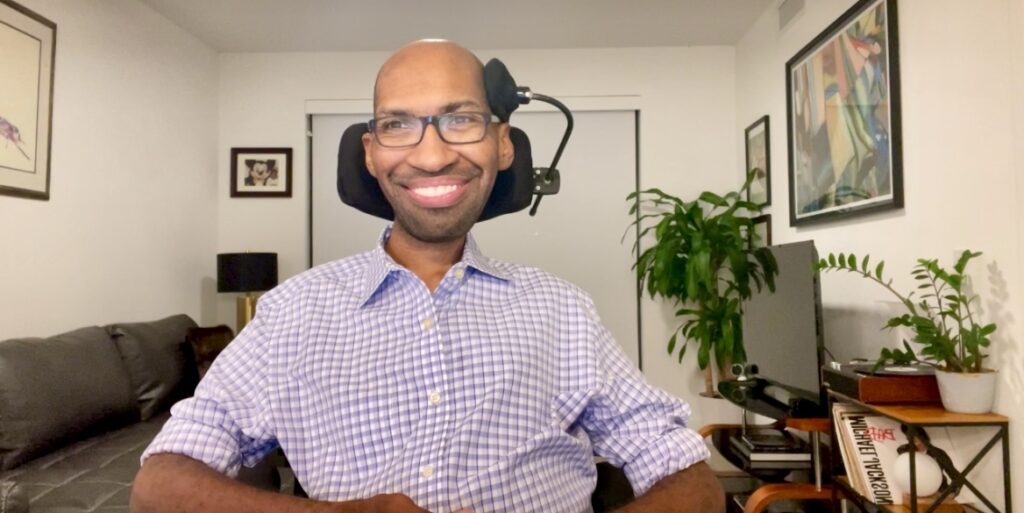
My Myotonic Dystrophy Journey
By Emily Blume | Monday, November 20, 2023
“Can you remember anything unusual from your childhood?” my neurologist probed. As I sat in the white-walled doctor’s office with my mom, neither of us could come up with anything. Dustin Smyth, DO, a neuromuscular disease specialist, was looking for indicators that may have gone unnoticed at the time.
I didn’t know it then, but his advice and care would be life-changing for me in the best possible way.

Emily Blume’s parents visited her in the newsroom.
In terms of my childhood health, it was seemingly uneventful. A full, happy, charmed childhood without a blip on the radar. They say ignorance is bliss, and it was for the first three decades of my life.
The initial signs of the disease surfaced in my late 20s, when I was working as a morning-shift television reporter in Davenport, Iowa. My alarm went off at 1:30 a.m. Monday through Friday, and I made it into the newsroom 45 minutes later. One morning in the fall of 2019, while reporting live, I suddenly struggled to finish the sentence that was scrolling across the teleprompter in front of me.
I couldn’t pronounce my words completely. It felt like my tongue froze. It was so unprecedented that I brushed it off and felt grateful nobody seemed to notice.
More than stress
In the years that followed, it happened more frequently, in different environments, and usually while I was under some sort of pressure. So, I chalked it up to stress. My neurologist would later explain that while stress triggered the myotonia (muscle spasm) in my tongue, it was not the root cause. At the time, however, myotonia was not part of my lexicon, so I’d refer to this phenomenon as “the tongue thing.”
Months later, “the tongue thing” materialized again, but this time it was my hands that froze. My heart dropped. “How could stress contribute to this?” I wondered.
By this point, I started to give more thought to something that previously never took up even an iota of space in my mind: My parents had used a sperm donor to have me. Could this be related?
Following the clues
After “the tongue thing” manifested as a muscle spasm in my hands, I figured it was time to see a new doctor. The symptoms were enigmatic to all the health professionals in my close circle, and Google wasn’t providing any clear answers, either.
I walked into what would be the first of many neurology appointments with a lofty list of possible clues. I discussed everything I thought could be related — including the sperm donor, whose medical history was a mystery to me.
I left that appointment with the words “myotonic dystrophy” (DM) scribbled across the top of my after-visit summary. This wasn’t a diagnosis, but it was a start.
In the weeks that I waited on the results of my genetic test, I reached out to the sperm bank my parents had used in hopes of finding answers. Myotonic dystrophy type 1 (DM1) is always inherited from the mother or father, and for each generation that inherits it, the symptoms manifest in more pronounced ways. This is called anticipation. Because my symptoms were on the mild side and emerged later in life, whoever passed it down to me was likely asymptomatic. So, at this point, inheriting it from my mom was just as strong a possibility as inheriting it from the donor.
The genetic counselor explained to me that they didn’t test donors for DM 30 years ago — and more alarming, they still don’t. Next, she started her search to get in touch with the man who donated more than 30 years ago.
The sperm bank was able to track down the donor, and he agreed to be tested for DM1. His cytosine-thymine-guanine (CTG) repeat count came back at over 50, which is just above the baseline for the asymptotic form of this disease, explaining why he never knew he had it. My mom was also tested, and her results came back negative.
Managing my health
When my genetic counselor presented my positive test for DM1, I was relieved. Now that I know what it is, I can learn how to manage it, I told myself.
With this newfound knowledge, I tracked down the aforementioned Dr. Smyth, a provider in Coeur d’Alene, Idaho, who has extensive experience with DM patients. He provided tactics and advice and prescribed me critical medications — mexiletine and modafinil — that control my myotonia and daytime fatigue.
“You can live into your 90s and die of something entirely unrelated,” Dr. Smyth reassured me. This has become my mantra on the days when fears of the unknown transpire.
I recognize I’m lucky beyond measure when compared to others who face greater health struggles. In the time since my diagnosis, I’ve learned the intricacies of what contributes to my symptoms and what I can do to manage my health as best as possible. Thankfully, I haven’t noticed any further disease progression.
Dr. Smyth’s care has been life-changing for me, and that’s a far cry from the “I’m sorry, there is nothing we can do” I got from the first neurologist I was referred to. We must be our own advocates. If your provider isn’t giving you answers or solutions to help, keep looking for someone who will.
While ignorance may have been bliss for some time in my life, knowledge is power today — and with that knowledge, I feel fortunate to have organizations like MDA that empower those of us living with neuromuscular diseases to live our best lives.
Emily Blume is a freelance journalist living in Washington State.
Next Steps and Useful Resources
- Find resources on genetics and genetic testing in MDA’s Print-Ready Education Materials.
- Read more personal stories about people living and thriving with neuromuscular diseases.
- Stay up-to-date on Quest content! Subscribe to Quest Magazine and Newsletter.
TAGS: Featured Content, From Where I Sit, Genetic Testing
TYPE: Featured Article
Disclaimer: No content on this site should ever be used as a substitute for direct medical advice from your doctor or other qualified clinician.




